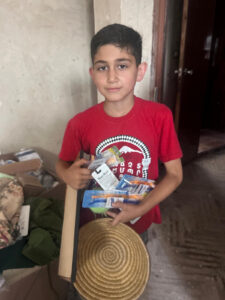 A donation of more than 32,000 toothbrushes has reached Armenia and is being distributed to Armenians through a number of charities, including Armenian General Benevolent Union (AGBU), Armenian International Dental Association, Armenian Missionary Association of America (AMAA), Children of Armenia Fund (CAF), Fund for Armenia Relief (FAR), and Knights of Vartan (see photo of a child in Armenia displaying some of the donated toothbrushes). The donation was received by AAHPO through President Lawrence V. Najarian, MD, and AAHPO facilitated the shipment of the donation.
A donation of more than 32,000 toothbrushes has reached Armenia and is being distributed to Armenians through a number of charities, including Armenian General Benevolent Union (AGBU), Armenian International Dental Association, Armenian Missionary Association of America (AMAA), Children of Armenia Fund (CAF), Fund for Armenia Relief (FAR), and Knights of Vartan (see photo of a child in Armenia displaying some of the donated toothbrushes). The donation was received by AAHPO through President Lawrence V. Najarian, MD, and AAHPO facilitated the shipment of the donation.
“AAHPO will be forever indebted for this gift, which will have a positive impact on Armenian people through needed, improved dental hygiene,” Dr. Najarian said.
“Oral health and dental care is directly linked to overall general health and well being. The link between periodontal health (gum disease) and heart disease has been known for years. Inflammation has been recognized as a common denominator in many diseases. There is a link between inflammation in the oral cavity and Cardiovascular disease, Stroke, Diabetes, Endocarditis, GI health, Rheumatoid arthritis as well as Alzheimer’s disease and Dementia,” noted AAHPO Treasurer Joyce Kurdian, DMD, who owns a private practice, Ridge Family Dentistry in Basking Ridge, NJ.
Dr. Kurdian added: “Oral care including toothbrushing is a simple way to help reduce inflammation in the mouth. In many areas of rural Armenia access to simple tools such as toothbrushes or floss is limited, which makes this donation so much more impactful. We are grateful for this very thoughtful donation.”
The donors of the toothbrushes are patients of Dr. Najarian, and have asked to remain anonymous. The toothbrush manufacturer intended to discard the toothbrushes because the packaging was mislabeled. The toothbrushes themselves are not defective.
When Dr. Najarian agreed to receive the donation on behalf of AAHPO, the donors made multiple trips in the sweltering summer weather to Dr. Najarian’s Bedminster office to deliver 111 cases of toothbrushes.
“I want to personally thank these anonymous donors for impacting the health trajectory of Armenian people, and making the world a healthier place,” Dr. Najarian said.
The donors were aware of Dr. Najarian’s connection to AAHPO. Dr. Najarian observed that any person who is involved with a charitable cause should make this connection known to others, as donations can come from unexpected places; “The funny thing about philanthropy is that it inspires more philanthropy. You never know when you might become part of a larger cycle of giving that impacts many people far beyond your immediate circle of influence. Helping others who are less fortunate is very rewarding.”
He added that members of the Armenian community and the local community are invited to support improved health care by participating in the Seventh Annual Run/Walk for Charity on November 4. The event raises funds to assist AAHPO’s Mission to provide medical support and education to local communities and Armenia.
